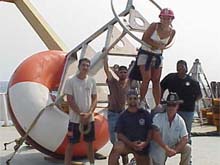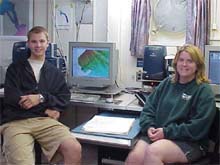
Members of the Hudson Canyon Ocean Exploration Science Team. From left to right: Tom, Jim, Peter, Kyle, Laura, Lisa and Tammie. Click image for larger view.
Deep Thoughts....by the HC '02 Science Team
September 16, 2002
Lisa M. Weiss, Watershed Coordinator
Jacques Cousteau National Estuarine Research Reserve,
with personal statements from all members of the science team
The Home Stretch
Today we will end our mapping and begin our final transit into New York City. Our ultimate destination is Pier 86 at the Intrepid Museum. We will have spent 19 days at sea. We are leaving with samples of water from the deep Atlantic. These samples will be taken back to Dr. Mary Scranton's lab at SUNY-Stony Brook where they will be analyzed to determine the levels of methane gas. Hopefully, these samples will be able to tell us something about the potential for methane vents on the seafloor surface and gas hydrates buried beneath the sediments.
We are leaving with a 60 X 110-mile mapped area of the geology below the ocean surface of the North Eastern Atlantic. We now have a better idea of what the geological features of this area look like. We have also learned what the seafloor sub-bottom looks like and how long-term geological processes have shaped the Hudson Canyon. Our mapping efforts will help oceanographers in the future as they hunt for creatures of the deep, search for novel energy resources and determine how our actions back on land impact the deep ocean.
But we are all leaving with much more than that. We haven't spent the last 18 days locked in a science box. We have been crossing back and forth over the Atlantic Ocean with the Ron Brown's officers and crew and have been surrounded by the majesty of a 360-degree ocean setting. We have made new friends and acquaintances, and learned new things that will help us both personally and professionally. We all will leave this ship changed in various ways.
Each one of us has had a different experience. Here are some individual thoughts from the members of the science team.

Jim (USGS) and Tom (Woods Hole Oceanographic) on the 03 deck of the Ron Brown. Click image for larger view.
Jim Robb: USGS; Woods Hole Field Center
I don't think of our mapping area as "ocean bottom." Rather, the map shows a submarine landscape as beautiful and awe-inspiring as any terrestrial vista. It will be fascinating to help work out the complex history and causes of the many features we see in the map we produced.
Tom Bolmer: Woods Hole Oceanographic Institute
I've had another chance to be out at sea and enjoy just watching it go by and the things in it. I never seem to be tired of doing that but I don't want to live out here. I have had a great chance to be part of a survey of something new and different in a world where much is already so well known. I also realize that I have much more to learn about the multibeam processing before I can say I understand all the aspects of it. This has been a difficult cruise since the data had such a difficult quality. On the other hand, this has been a great opportunity for me to be responsible for the overall processing of the multibeam data. As we near the end, I feel that we haven't had enough time out here and that I want to see more open spaces with the waves rolling by. But, that'll have to wait until my next chance to get to sea.
Collecting Benthic Animals
Tammie Middleton: USGS; Woods Hole Field Center
On many levels, this research cruise has stretched me professionally. One of the important lessons I have learned is how a ship is navigated and its relationship to the completion of science objectives. Teamwork has been an important skill to balance the multiple objectives of the different groups aboard. I have been excited by the possibilities of new data visualization tools and how we can best display this data we collect. I am eagerly looking forward to relating our "finds" to the public once we get to New York. All in all, it has been a good experience.
Kyle Kingman: Student, Rutgers University
What I got out of this cruise is far more than a lot of data to sift through back at home. I spent twenty days getting immersed in priceless experiences. While at sea, I've had many lessons I couldn't have learned in a classroom such as professionalism, patience, poise, discipline, and composure under dire circumstances. I will leave with a deeper and more accurate understanding of how our ocean works above and below the waves.

A schematic drawing of the electrophysiology apparatus used to study the color and light sensitivity of deep sea benthic organisms.
Lisa Weiss: Watershed Coordinator
Jacques Cousteau National Estuarine Research Reserve / Rutgers University
I know that I have had a far different experience than the rest of the science team. As the Educational Coordinator, it has been my task to translate the Hudson Canyon Exploration back to all of you who normally wouldn't be able to participate in an oceanographic exploration. To accomplish this goal, I have made it a point to immerse myself in all the aspects of this exploration. I have stood science watches with the rest of the research team. I have edited mapping data. I have painted with the deck crew and baked dessert in the galley. I have learned more about an engine room than I thought possible and spent time on the bridge learning about navigation and weather. For me, the most important thing that I have learned is that it takes more than a science team to have a successful oceanographic mission. It takes every single crew member onboard the Ron Brown to make this exploration possible and valuable. For me, it has reinforced my love of the ocean, increased my desire to continue science translation and has lit a flame in me to pursue similar missions in the future.
Dr. Peter Rona: Marine Geologist-Rutgers University
What an adventure exploring this greatest of all North American submarine canyons and the surrounding region! We have seen with our echo-sounding instruments the many forms of this majestic canyon. We have traced the canyon seaward from walls towering over half a mile high where the canyon traverses the continental slope, to meandering channels across the upper continental rise, to a narrow gorge on the middle continental rise. We have seen great blocks of sedimentary strata, some as high as the Empire State Building, that have slumped onto the upper continental rise at the base of the continental slope. Now we are returning home where we plan to produce a map that will display this new information. We will prepare scientific papers to interpret this information in terms of the resource potential and environmental processes of the Hudson Canyon region for the benefit of all.
Sign up for the Ocean Explorer E-mail Update List.
























